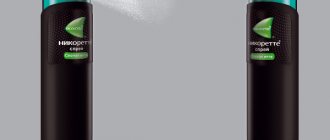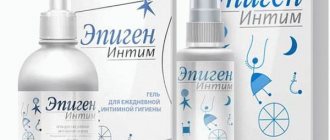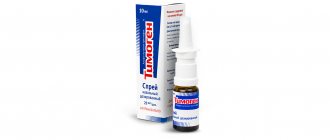Septolete total 30ml dosed spray for topical use
pharmachologic effect
non-steroidal anti-inflammatory drug + antiseptic
Composition and release form Septolete total 30ml dosed spray for topical use
benzydamine + cetylpyridinium chloride
dosed topical spray
1 spray dose/1 ml spray
Active ingredients:
Benzydamine hydrochloride 0.150 mg/1.50 mg
Cetylpyridinium chloride monohydrate 0.526 mg/5.26 mg, equivalent to cetylpyridinium chloride 0.500 mg/5.00 mg
Excipients: ethanol, glycerol, macrogol glyceryl hydroxystearate, sodium saccharinate, peppermint leaf oil, purified water
1 dose of the drug is about 0.1 ml of solution.
30 ml of the drug in the primary package contains 250 doses.
Description of the dosage form
Transparent solution from colorless to yellowish.
Directions for use and doses
Locally.
Adults and children over 12 years old
To receive a single dose, press the spray head 1-2 times.
It is recommended to apply every 2 hours, 3-5 times a day for 4 days.
Children aged 6 to 12 years
To receive a single dose, press the spray head once. It is recommended to apply every 2 hours, 3-5 times a day for 4 days.
In children aged 6 to 12 years, the drug should be used only after consulting a doctor.
Do not exceed the indicated dose.
To achieve optimal results, it is not recommended to use Septolete® total immediately before or after brushing your teeth.
If there is no improvement after treatment or new symptoms appear, you should consult your doctor.
Use the drug only according to the method of use and in the doses indicated in the instructions.
If necessary, please consult your doctor before using the medicine.
You should contact your doctor if symptoms worsen or do not improve after 4 days of treatment.
Mode of application
Before using Septolete® total for the first time, press the spray head of the dosing device several times until a uniform spray is obtained. If Septolete® total has not been used for a long time (for at least 1 week), press the spray head of the dosing device once until a uniform spray is obtained.
| Before use, remove the colored protective cap. |
| Open your mouth wide, point the applicator tube into the oral cavity, hold your breath and press the spray head 1-2 times. |
After each use of Septolete® total, cover the spray head with the colored protective cap.
By pressing the spray head once, 0.1 ml of solution is released in the form of a spray, which contains 0.15 mg of benzydamine and 0.5 mg of cetylpyridinium chloride.
Pharmacodynamics
Benzydamine is a non-steroidal anti-inflammatory drug with anti-inflammatory, analgesic and local anesthetic effects. Cetylpyridinium chloride is an antiseptic from the group of quaternary ammonium compounds, has antimicrobial, antifungal, and virucidal effects.
Pharmacokinetics
Suction
Of the two active ingredients - cetylpyridinium chloride and benzydamine - only benzydamine is absorbed through the mucous membranes. Therefore, cetylpyridinium chloride does not interact pharmacokinetically with benzydamine at the systemic level.
The absorption of benzydamine through the mucous membranes of the oral cavity and pharynx was shown by detecting the active substance in the blood serum, the amount of which, however, was insufficient to provide a systemic effect.
When benzydamine is used in topical spray dosage form at recommended doses, absorption is negligible.
Distribution
The volume of distribution of all dosage forms is the same.
Removal
Excretion occurs mainly by the kidneys, mostly in the form of inactive metabolites. The half-life and total clearance are similar for all dosage forms.
Indications for use Septolete total 30ml dosed spray for topical use
Symptomatic treatment of pain syndrome of inflammatory diseases of the oral cavity and ENT organs (of various etiologies), including tonsillitis, pharyngitis, as part of complex therapy.
Contraindications
- Hypersensitivity to the active substances or to any auxiliary components of the drug.
- Children's age up to 6 years.
- Pregnancy, breastfeeding period.
Hypersensitivity to acetylsalicylic acid or other non-steroidal anti-inflammatory drugs, bronchial asthma (including a history), liver disease, alcoholism, traumatic brain injury, brain diseases.
Application of Septolete total 30ml spray for topical use, dosed during pregnancy and breastfeeding
The use of Septolete® total is contraindicated during pregnancy and breastfeeding. If it is necessary to use the drug during lactation, breastfeeding should be discontinued.
Children over 12 years old
To receive a single dose, press the spray head 1-2 times.
It is recommended to apply every 2 hours, 3-5 times a day for 4 days.
Children aged 6 to 12 years
To receive a single dose, press the spray head once. It is recommended to apply every 2 hours, 3-5 times a day for 4 days.
In children aged 6 to 12 years, the drug should be used only after consulting a doctor.
Contraindicated for children under 6 years of age.
special instructions
Read the instructions carefully before you start using the drug. Save the instructions, you may need them again. If you have any questions, consult your doctor.
The medicine you are using is intended for you personally and should not be given to others as it may cause harm to them even if they have the same symptoms as you.
When using the drug Septolete® total, a hypersensitivity reaction to the drug may develop. In this case, it is recommended to stop treatment and consult a doctor to prescribe appropriate therapy.
If there is an ulcerative lesion of the mucous membrane of the oropharynx, the patient should consult a doctor if symptoms persist for more than three days.
The use of Septolete® total is not recommended in patients with hypersensitivity to acetylsalicylic acid or other non-steroidal anti-inflammatory drugs.
The drug Septolete® total should not be used simultaneously with anionic compounds (for example, present in toothpaste). Therefore, it is not recommended to use the drug immediately before or after brushing your teeth.
Contact of Septolete® total with the mucous membrane of the eyes should be avoided.
The spray should not be inhaled.
A single dose of Septolete® total contains 0.0264 g of absolute ethyl alcohol, the maximum daily dose of Septolete® total for children 6-12 years old contains 0.132 g of absolute ethyl alcohol, for children 12 years of age and older and adults – 0.264 g.
After opening the bottle, the drug should be used within 6 months.
Applications for chronic diseases:
Take with caution in patients with bronchial asthma (including a history), liver diseases, brain diseases, and alcoholism.
Impact on driving:
During the period of use of the drug, care must be taken when performing potentially hazardous activities that require increased concentration and speed of psychomotor reactions (driving vehicles, working with moving mechanisms, working as a dispatcher, operator).
Overdose
Symptoms
Intoxication is possible only through accidental ingestion of significant quantities of benzydamine (> 300 mg). In case of benzydamine overdose, symptoms are observed, mainly from the gastrointestinal tract (GIT) and the central nervous system (CNS). The most common gastrointestinal symptoms are nausea, vomiting, abdominal pain and irritation of the esophageal mucosa. CNS symptoms include dizziness, hallucinations, agitation, restlessness, and irritability.
Signs and symptoms of intoxication when ingesting significant quantities of cetylpyridinium chloride: nausea, vomiting, edema, cyanosis, dyspnea, asphyxia with subsequent paralysis of the respiratory muscles, depression of the central nervous system, arterial hypotension and coma. The lethal dose for humans is about 1-3 g.
Treatment
In case of acute overdose of benzydamine, treatment is symptomatic. Medical supervision, supportive care and adequate hydration should be provided.
Treatment of cetylpyridinium chloride overdose is also symptomatic. In case of overdose, consult a doctor.
Side effects Septolete total 30ml spray for topical use, dosed
Classification of the frequency of side effects recommended by the World Health Organization (WHO):
very common ≥ 1/10
often from ≥ 1/100 to
uncommon ≥ 1/1000 to
rarely from ≥ 1/10000 to
very rarely
frequency unknown cannot be estimated from available data.
Immune system disorders:
frequency unknown: hypersensitivity reactions, anaphylactic reactions.
Nervous system disorders:
frequency unknown: numbness of the oral mucosa.
Disorders of the respiratory system, chest and mediastinal organs:
rarely: bronchospasm.
Gastrointestinal disorders:
very rarely: irritation of the oral mucosa, burning sensation in the mouth.
Disorders of the skin and subcutaneous tissues:
rarely: urticaria, photosensitivity;
frequency unknown: angioedema, skin itching.
If any of the side effects indicated in the instructions get worse, or you notice any other side effects not listed in the instructions, tell your doctor.
Drug interactions
Not described. Simultaneous use with other drugs from the group of antiseptics should be avoided.
Septolete Plus spray for local use. approx. (10mg+2mg)/ml per bottle. 30ml per pack. No. 1
Name
Septolete Plus spray for local use. approx. (10mg+2mg)/ml per bottle. 30ml per pack. No. 1
Description
Transparent liquid from colorless to yellowish
Main active ingredient
benzocaine - 10.0 mg cetylpyridinium chloride - 2.0 mg,
Release form
Dosage
spray (10mg+2mg)/ml
special instructions
Due to the increased risk of developing methemoglobinemia, it should be used with caution in patients with difficulty breathing (for example, asthma, bronchitis), in patients over 65 years of age, in patients with heart disease. These categories of patients should use Septolete® plus spray only after consulting a doctor. The drug should not be used on open wounds in the oral cavity, since cetylpyridinium chloride slows down wound healing. For severe infections accompanied by severe sore throat, high fever, headache and vomiting, a doctor's consultation is necessary, especially if the condition does not improve within 3 days. Contact of the spray with the mucous membrane of the eyes should be avoided; The spray must not be inhaled. After using the spray, you may experience a temporary burning sensation, numbness in the mouth or throat, or difficulty swallowing. These symptoms may make it difficult for patients to eat and drink or, more likely, lead to lip and/or tongue biting, so it is recommended that patients avoid eating, drinking, chewing gum, or brushing their teeth for at least 1 hour after ingestion. drug. You should not take Septolete® plus spray for a long time or too often during the day, since taking doses of the drug exceeding the recommended ones increases the risk of developing serious undesirable effects. Septolete® plus spray does not contain sucrose, so it can be used by patients with diabetes. Septolete® plus spray contains a small amount of ethanol - less than 100 mg per dose. Use in pediatrics Septolete® plus is recommended for use in children under 6 years of age, since data on the safety of the drug in this category of patients are limited. Effects on the ability to drive vehicles and operate machinery. The effect of Septolete® plus spray on the ability to drive a vehicle and operate machinery has not been reported.
Pharmacological properties
Pharmacodynamics
Cetylpyridinium chloride is an antiseptic substance from the group of quaternary ammonium compounds and acts as a cationic disinfectant. Quaternary ammonium compounds bind to the bacterial cell surface, diffuse through it, and bind to the microbial cytoplasmic membrane. As a result of this binding, the cytoplasmic membrane becomes permeable to low molecular weight components, mainly potassium ions. Quaternary ammonium compounds then penetrate into the cell, and finally damage to cell functions thus causes cell death. Cetylpyridinium chloride has a broad spectrum of antimicrobial action, its antimicrobial effect is most pronounced against gram-positive bacteria (for example, Staphylococcus). Gram-negative bacteria are moderately sensitive to cetylpyridinium chloride, while some Pseudomonas species are relatively unsusceptible. Cetylpyridinium chloride also has an antifungal effect (for example, against Candida and Saccharamyces) and an antiviral effect against some enveloped viruses. Benzocaine blocks the conduction of impulses along the nerve fiber, including the conduction of pain impulses, thereby eliminating the feeling of pain. The conductivity of the nerve fiber is blocked as a result of a decrease in the permeability of the nerve cell membrane to sodium ions.
Pharmacokinetics
There are no data on the pharmacokinetics of cetylpyridinium chloride. Quaternary ammonium compounds are known to be poorly absorbed, only 10% to 20%. The unabsorbed portion is excreted unchanged from the body in feces. Data on the pharmacokinetics of benzocaine are also very limited. Some local anesthetics, including benzocaine, are known to be poorly soluble in water and therefore are minimally absorbed. Absorbed benzocaine is mainly hydrolyzed by plasma cholinesterase and a smaller portion is metabolized in the liver. Decomposition products are excreted in the urine.
Indications for use
Septolete® Plus spray is recommended for symptomatic relief of sore throat in: - inflammatory diseases in the mouth and throat (pharyngitis, laryngitis, inflammation of the gums and oral mucosa, stomatitis, gingivitis) - colds and flu in complex therapy
Directions for use and doses
When you press the head of the bottle once, 0.15 ml of solution is injected. The course of treatment is no more than 7 days. Adults and adolescents over 12 years of age: For a single dose, press the head of the spray bottle twice. This procedure can be repeated every 2 - 3 hours up to 8 times a day. Children from 6 to 12 years: For a single dose, press the head of the spray bottle once. This procedure can be repeated every 2 - 3 hours up to 4 times a day. Children should be supervised by adults when using the spray. Directions for use Before using Septolete® Plus spray for the first time, or if the product has not been used for a long time, press the head of the spray bottle several times (5 - 9 times) into an open space or sink until small drops appear.
Use during pregnancy and lactation
There are no data on the safety of the drug in pregnant women, or their number is limited. Studies on experimental animals are insufficient to establish the effect of the drug on pregnancy and fetal development. The use of Septolete® plus spray during pregnancy and breastfeeding is not recommended.
Precautionary measures
Interaction with other drugs
There is no data on the interaction of cetylpyridinium chloride and benzocaine with other drugs. Septolete® plus should not be taken with milk, as this product reduces the antimicrobial activity of cetylpyridinium chloride.
Contraindications
alcohol addiction; methemoglobinemia; hypersensitivity to the active substances or other components of the drug; hypersensitivity to other local anesthetics.
Compound
1 ml of spray contains active substances: benzocaine - 10.0 mg cetylpyridinium chloride - 2.0 mg, excipients: 96% alcohol, glycerin, sodium saccharin, peppermint oil, purified water
Overdose
Due to the low concentrations of active components in Septolete® plus spray, overdose is practically impossible. Long-term use of the drug in doses higher than recommended, or too frequent use over a short period of time, may lead to methemoglobinemia. If signs of intoxication appear, use of the drug should be stopped immediately. And depending on the degree of oxidation of hemoglobin, mild symptoms of overdose may appear, such as headache, cyanosis, fatigue, shortness of breath. In more severe forms of methemoglobinemia, palpitations, seizures, cardiac arrhythmia, and coma may sometimes occur. When taking doses of the drug that exceed the recommended ones, gastrointestinal disorders such as nausea, vomiting and diarrhea may occur. Cetylpyridinium chloride may cause nausea and vomiting due to irritation of the gastrointestinal mucosa. Treatment includes the administration of 100% oxygen; in more severe cases, the antidote methylene blue is used, and gastrointestinal decontamination (gastric lavage, ingestion of activated charcoal) is also indicated.
Side effect
From the hematopoietic system: rare - methemoglobinemia. From the digestive system: rare - gastrointestinal disorders1. From the immune system: infrequent - hypersensitivity reactions2 (rash, itching, swelling, difficulty breathing).
Storage conditions
The drug should be stored out of reach of children at a temperature not exceeding 25°C.
Buy Septolete Plus topical spray. approx. (10mg+2mg)/ml per bottle. 30ml per pack. No. 1 in pharmacy
Price on Septolete Plus topical spray. approx. (10mg+2mg)/ml per bottle. 30ml per pack. No. 1
Instructions for use for Septolete Plus topical spray. approx. (10mg+2mg)/ml per bottle. 30ml per pack. No. 1


